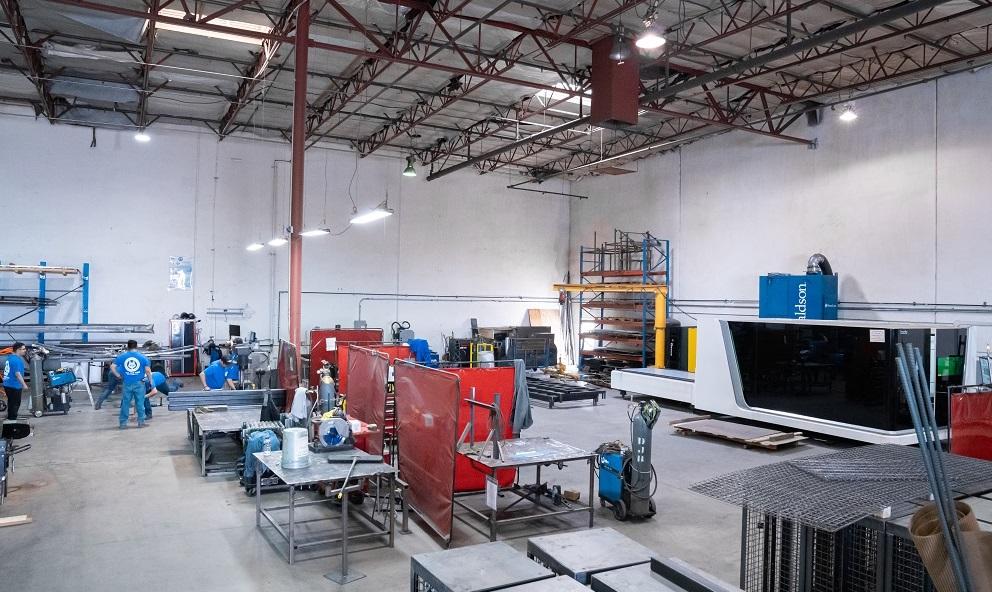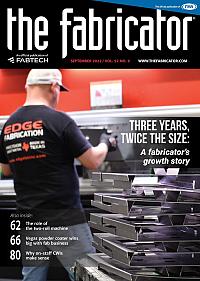Contributing editor
- FMA
- The Fabricator
- FABTECH
- Canadian Metalworking
Categories
- Additive Manufacturing
- Aluminum Welding
- Arc Welding
- Assembly and Joining
- Automation and Robotics
- Bending and Forming
- Consumables
- Cutting and Weld Prep
- Electric Vehicles
- En Español
- Finishing
- Hydroforming
- Laser Cutting
- Laser Welding
- Machining
- Manufacturing Software
- Materials Handling
- Metals/Materials
- Oxyfuel Cutting
- Plasma Cutting
- Power Tools
- Punching and Other Holemaking
- Roll Forming
- Safety
- Sawing
- Shearing
- Shop Management
- Testing and Measuring
- Tube and Pipe Fabrication
- Tube and Pipe Production
- Waterjet Cutting
Industry Directory
Webcasts
Podcasts
FAB 40
Advertise
Subscribe
Account Login
Search
Las Vegas powder coater expands business into metal fabrication
Wolf Powder Coating takes reverse approach to implementing processes
- By Kate Bachman
- September 19, 2022
- Article
- Finishing
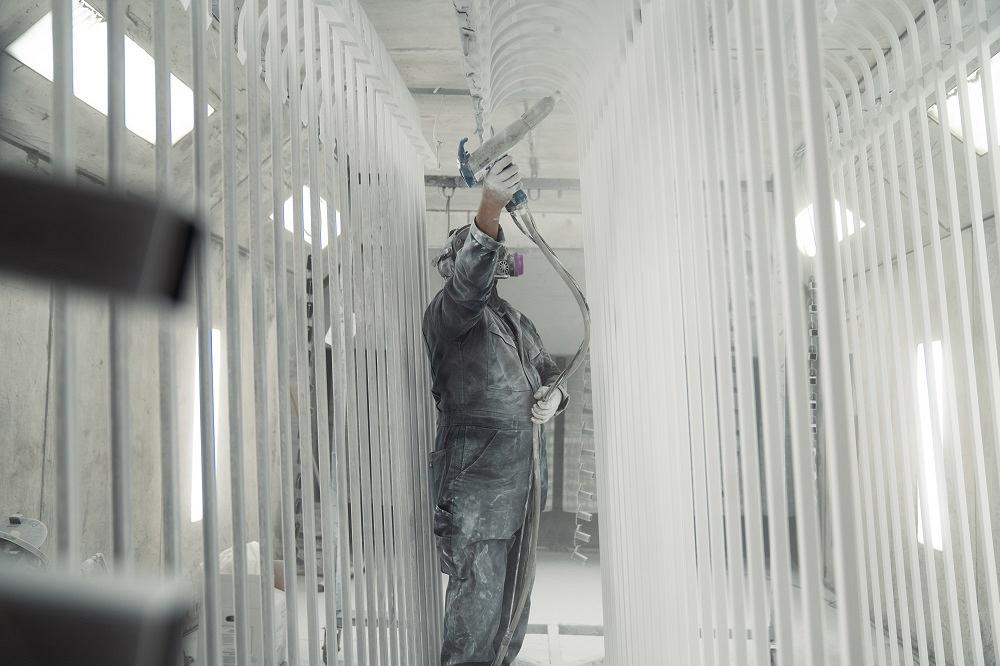
Portillo invested in application guns that are equipped with technology that measures and shows how much powder is being applied for each particular job and each part. Images: Wolf Powder Coating
Usually, the road to running a powder coating operation starts with a metal fabricating business that expands to onboard powder coating. Wolf Powder Coating took the reverse approach. It started as a powder coating business and has now expanded to offer fabrication to its powder coating customers.
Starting Out
Wolf Powder Coating President Alfredo Portillo has a background in construction as a journeyman plumber. He wanted to run a business. “I always had the desire to have my own company.” He and his sister started a maintenance company in Las Vegas, including maintaining the electric escalators along Las Vegas Boulevard that move walkers on and off the pedestrian overpasses that traverse the strip. In doing so, he saw that refurbishing the stairs required powder coating.
“I was hooked on powder coating from the beginning,” Portillo said. “It’s amazing how powder will stick to parts, and how they come out with that beautiful finish after being cured in the oven.”
Five years ago, he considered launching powder coating as a business, but said he didn’t have a good sense as to its potential in Las Vegas. Then he did small statistical study to identify potential customers and competitors.
“A lot of good customers were still doing liquid painting. There were a handful of powder coating shops. Some of them very reputable, but also very expensive. Others were a little more affordable, but they were cutting corners in their processes, and were not achieving the best quality.”
Full Launch
Portillo found instructional information from many sources: He read articles, followed several sites, and watched YouTube series episodes.“I started to piece it together and make my own sense about what I was really jumping into.” Based on his research, Portillo decided to spin the wheel and launch a full powder coating business.
Differentiation Through Customer Service. The first thing Portillo did was to excel at service. “We offered pickup and delivery service. We offered quick turnarounds. We quickly stocked hundreds of colors for the clients to choose from. And we really catered to their needs.” Those are some of the actions that helped him differentiate the company and grow very quickly, he said.
Investment. Portillo said he knew he had to make a pretty large capital investment. He invested in a full-scale operation, but incrementally.
“Every capital investment came out of need. We started with a small oven, and we had to overcome that very quickly because we started to get big jobs. We saw the need for more production. Then we jumped to getting a bigger oven and we stayed there for about a year or two and we were very happy, but of course, we overcame that very quickly because we saw the need for a conveyorized system. And we bought one of those.
“It was a challenge to pay for the capital equipment,” he conceded. “It is expensive. We had to finance it. But since day one we've committed to investing in the business. We have invested in having the right equipment that will achieve the best results—one of them being our powder coating guns.”

Wolf Powder Coating’s training program includes teaching employees how to use the equipment, the way the powder behaves, and how it flows through the gun and attaches to the part and familiarizing them with the hundreds of colors the company stocks.
About two years ago, he invested in application guns that are equipped with technology that measures and shows how much powder is being sprayed for each particular job. “We can know how much powder we're applying per part. And it makes a world of difference.”
Today, Wolf Powder Coating has a full, industrial powder coating operation with a five-stage wash system, sand blasting system, conveyor system, powder applications guns, and a 44-ft.-long convection oven that is large enough to finish nearly any part size.
“So now we are at the point with these two ovens, our top-of-the-line applicators, the wash system, and the conveyors to work two or three shifts and to really bring production to another level.”
The company has annual sales of $2.7 million, a 25,000-sq.-ft. building, and 46 employees.
Powder Coating Process
The process of powder coating can be a little tricky, Portillo relayed. “It's not simple. Not knowing the right steps to follow can get you into a lot of trouble, right? So, we were very careful from the beginning.” He added, “We made our mistakes that we had to overcome, but nothing that we couldn't fix.”
Pretreating. Portillo said that the process starts with identifying the type of pretreatment the parts need—whether it is sandblasting or chemical pretreatment—to achieve the best results.
“Using the chemical pretreatment, we wash the part with hot chemicals to create adhesion to where the powder can stick and grab onto the metal and have the best bond possible.”
From pretreatment, the parts go into the oven on a conveyor system and to the painting process, which is the powder application.
Coating. The part has to be electrostatically charged first. The gun itself produces the charge, Portillo explained. “We connect the ground cable to the rack where this part is hung or directly to the part. That's how that electrostatic energy gets to the part and it gets charged. Then when the painter shoots the powder, the charged molecules wrap around the metal and the powder stays on it. When you move the rack around, the powder doesn't fall off. Gravity doesn't affect the powder.”
Curing. From there, the parts continue on the conveyor to the oven for the coatings to cure, which is the final stage. “Our convection oven is older technology that has been used for several years. But it is the best way to achieve the best curing possible of these parts. We use top-of-the-line gas burners that operate with natural gas. It’s very efficient. They heat up in no time and have a consistent temperature of 400 degrees F to cure the parts. From there, our conveyorized systems give us the ability to produce thousands of parts per day, depending on the particular part.”
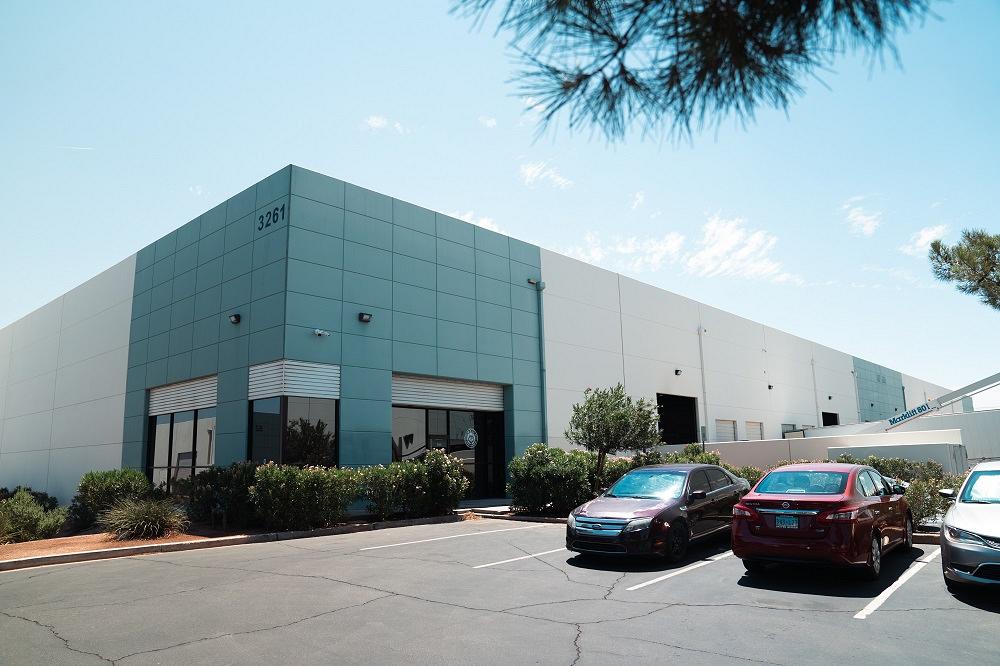
Wolf Powder Coating started with a countertop curing oven in the owner’s home and is now a $2.7 million annual sales business operating out of a 25,000-sq.-ft. building with 46 employees.
Projects, Customers
Portillo said that most of his customers are in the Las Vegas Valley area within the convention and casino industry, but some are from California, Arizona, and New York. Many are construction companies that win contracts in Las Vegas. Customers include manufacturing companies. Projects and parts vary widely, he said. “They can be anything from artistic aluminum ceiling designs for the casinos to fencing and gates for the construction sector or small brackets for manufacturing assembly.
“Everything in the casino industry is back on track. So we do work on all the shows— there are a lot of aluminum components. When you’re in a fancy restaurant on the strip and see beautiful chandeliers or architectural features in the ceiling, that's all powder coated. We have done thousands of gaming machines.”
One of the unique aspects of supplying to casinos and convention centers is that they don’t have a “shut-down” time for assessing wear and maintenance.
“They're 24/7. So, of course, they keep us working 24/7. They don't shut down at night and look around and say, ‘OK, we need this for tomorrow.’ They're always on the run. Everything that has to do with the casino industry is always last minute. That's a day-to-day thing now.
“That's where our ability to turn things around quickly makes us different from our competitors,” he continued. “We don’t mind tackling all these last-minute jobs.”
Finding, Hiring, Retaining Personnel
One of the biggest obstacles the business has, especially after the pandemic, is finding and hiring good personnel, Portillo relayed. “Without a doubt, it’s really about finding the right people with the right attitude to come and work every day. We can have the best equipment, the best facility, but more important is our personnel … We are screening on a daily basis for that quality employee who has what it takes. How we overcome that is to train our own people—and to pay the best wages,” he said.
“We offer very aggressive wages,” Portillo continued. “We wanted to be the company that offers the best rates.” As a result, the trend has reversed, and people are clamoring to work at Wolf Powder Coating. “We are in a position to choose the right people with the right mentality that we feel will fit our team.”
He added, “That also meant being able to organize ourselves into being more effective.” A year ago, Wolf Powder Coating adopted the Toyota Production System (TPS) and implemented lean manufacturing. In addition, it developed its own software to help control every aspect of the whole operation, from the cost of the powder for each job to the labor that's involved to the time that it takes to deliver a product.
“We learned through TPS that we needed to create our own culture. So, each of our employees undergoes very extensive training.”
Setting Up a Training Program
Portillo explained how he set up new employee training.
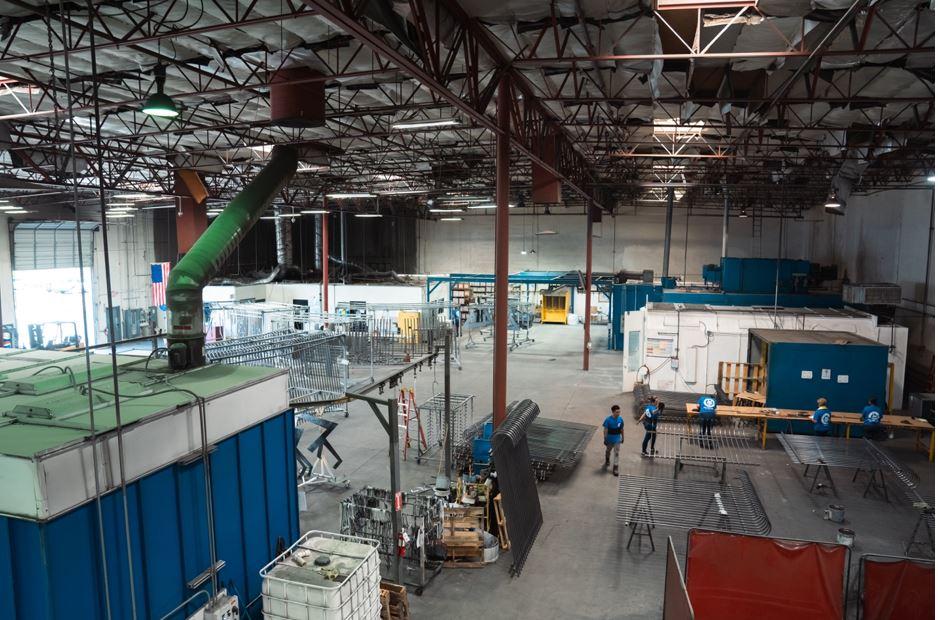
Wolf Powder Coating is equipped with two baking ovens, including a 44-ft.-long convection oven, top-of-the-line applicators, a five-stage wash system, and conveyors.
“Let's say we identify someone who has what it takes to become a painter, potentially. They go through safety orientation first. They watch a safety orientation video. And then we start a training plan where they basically shadow an existing employee so they can view the process.”
From there, they attend a class that covers the whole process. It starts from the use of the equipment, the way the powder flows through the gun, the way the powder attaches to the part, basically giving them a full understanding of how the powder behaves, he said.
“Being a painter can be a bit tricky. It's not just pushing the trigger of the gun and spraying. You have to understand the shape of each part and their complexity. The thickness of the part also plays a role … and, of course the variety of colors. There are greens, reds, whites, metallics, textures …,” Portillo said.
Initial training for a painter takes about two weeks so they can be briefed on the whole process. Training is ongoing. The painter in training must achieve different steps and gets a reward each time they complete that step successfully. They start with the simplest colors. Once they achieve that, they move on to do other colors, metallic colors, and then texture colors. “At the end of the whole course, they get their diploma that they can display on the wall and feel proud of achieving. Every month or so they get challenged on another task so they can stay up to date.”
It’s critical to ensure that the equipment is working properly, especially the natural gas-burning ovens, because of their combustibility. So, having the best maintenance team possible is key, Portillo relayed.
The painters may perform the most basic maintenance, which is to change the nozzles, he said. “But when it comes to troubleshooting a gun … there are tiny tubes that have to be connected. The assembly is tedious and requires time. We have had instances where we had to disassemble the whole gun to change the cascade, which is a very expensive part inside the gun. We have a team in charge of their maintenance who have been trained on how to do that properly.”
Future Diversification: Fabrication
Now that he has powder coating under his belt, Portillo wants to expand into more metal fabrication. “We saw a need again. Most recently we started to take on fabrication jobs for our customers.”
He explained that most of his customers who do fabrication don't have a laser or a plasma machine to cut their plates. “We saw that maybe we could include that service to help them do that. They may not need a fiber laser every day in their facility, but when they do need one, they know that they can come to us. We can cut and powder coat the metal at the same time. In some cases, the laser cutting has been helpful for them, and we have grown our relationship with them.”
Portillo said he’s careful not to be a rival to his customers. “We definitely don't want to compete with our clients.
“It's very beneficial for us to implement these types of things. Where can you help them? What can you do to simplify things?”
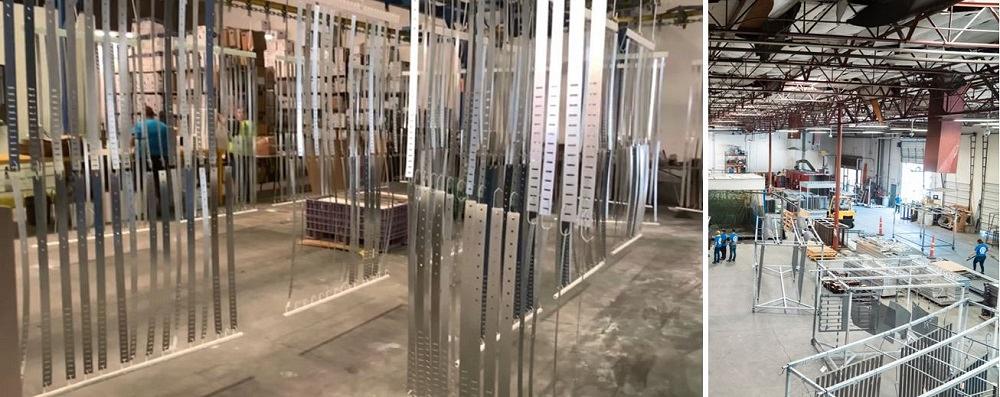
Projects range from artistic aluminum ceiling designs for the casinos to fencing and gates for the construction sector or small brackets for manufacturing assembly. Most customers are in the Las Vegas Valley and are active in the convention and casino industry, but some are from California, Arizona, and New York.
Portillo has another use for the lasers. He owns a second company called El Jefe Offroad that fabricates custom off-road cars for the desert. “That was also the reason for getting a fiber laser and fabrication equipment. That business will benefit from it. So that's like our No. 1 client, right?’” he joked.
Early Beginnings Prove Useful
Portillo said he believes that his origins in construction have helped him in his powder coating and fabrication business.
“I feel that it helped me a lot to find the common sense of things … to understand, and to have the vision, from the creation of something into what the end result is going to be. Where is it going? What is it doing? So, that definitely has played a role in understanding what the components are that the people are bringing us to powder coat and to be able to better help them.”
Again, It’s the People
“We have built a great team of people, from the salespeople to the project engineers, office management, painters, blasters, drivers … everybody who plays a role. We're very proud of them,” Portillo said.
“Without a doubt, finding the right employees that share the same vision and help us be different and continue to grow, to adopt technology, to find better ways to do things … Without a doubt, that’s the biggest challenge and the biggest thing that helps us succeed.”
Investing in his employees was key to growing the operation, Portillo commented. “Otherwise, from experience, employees just look for better opportunities somewhere else—and the ones who stay are not very dedicated. Now when people get the opportunity to work here, they stay. It makes a difference. We get the job done right.
“While everybody else was looking to cut costs, we went the opposite way, offering more money to people. I think it gives us the best results for sure.”
Portillo added, “I think that it's a good moment, a good time for us. We’ve had a lot of blessings, that's for sure. We've been very blessed from the beginning.”
About the Author

Kate Bachman
815-381-1302
Kate Bachman is a contributing editor for The FABRICATOR editor. Bachman has more than 20 years of experience as a writer and editor in the manufacturing and other industries.
subscribe now

The Fabricator is North America's leading magazine for the metal forming and fabricating industry. The magazine delivers the news, technical articles, and case histories that enable fabricators to do their jobs more efficiently. The Fabricator has served the industry since 1970.
start your free subscription- Stay connected from anywhere

Easily access valuable industry resources now with full access to the digital edition of The Fabricator.

Easily access valuable industry resources now with full access to the digital edition of The Welder.

Easily access valuable industry resources now with full access to the digital edition of The Tube and Pipe Journal.
- Podcasting
- Podcast:
- The Fabricator Podcast
- Published:
- 04/16/2024
- Running Time:
- 63:29
In this episode of The Fabricator Podcast, Caleb Chamberlain, co-founder and CEO of OSH Cut, discusses his company’s...
- Trending Articles
Tips for creating sheet metal tubes with perforations

JM Steel triples capacity for solar energy projects at Pennsylvania facility

Are two heads better than one in fiber laser cutting?

Supporting the metal fabricating industry through FMA

Omco Solar opens second Alabama manufacturing facility

- Industry Events
16th Annual Safety Conference
- April 30 - May 1, 2024
- Elgin,
Pipe and Tube Conference
- May 21 - 22, 2024
- Omaha, NE
World-Class Roll Forming Workshop
- June 5 - 6, 2024
- Louisville, KY
Advanced Laser Application Workshop
- June 25 - 27, 2024
- Novi, MI
























